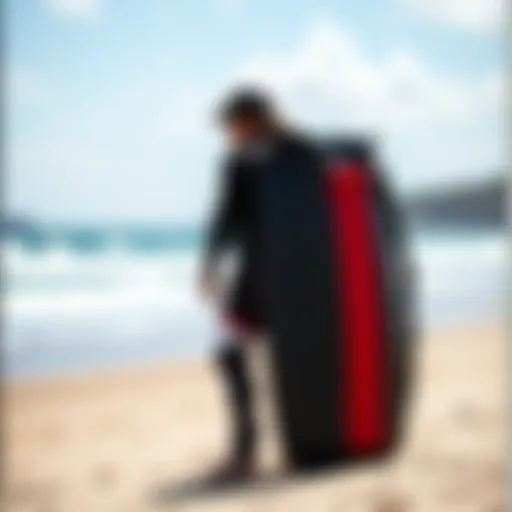Your Guide to Buying Used Hydrofoil Surfboards


Intro
Hydrofoil surfboards have made waves in the water sports world, giving kiteboarders a new level of excitement. If you're eyeing a pre-owned hydrofoil surfboard, you're in for a unique experience. While the thrill of riding a hydrofoil may be enticing, navigating the market for used boards requires some insider knowledge. In this guide, we will unpack the essential elements involved in selecting the right hydrofoil surfboard for yourself.
More than just a tool for kiteboarding, a hydrofoil surfboard changes how you feel on the water. This article dives deep into various aspects of finding a used board, from understanding the types available on the market to evaluating their pricing and maintenance needs.
By the end of this journey, you'll not only know what to look for in a hydrofoil surfboard but also gain a clearer perspective on the technology behind them and how they can elevate your kiteboarding adventures.
Gear Insights
When purchasing a used hydrofoil surfboard, it’s crucial to get to know the gear you're dealing with. With various types of boards and foils available, taking time to understand your options can make a world of difference.
Types of Hydrofoil Surfboards
- All-around Boards: Perfect for diverse conditions, these are versatile and often the best starting point for beginners. They can handle flat water and small waves.
- Surf Foils: Designed specifically for waves, they allow for smooth rides even in tricky surf conditions. If you're looking to carve up the waves, this might be your best bet.
- Race Foils: These are engineered for speed and performance, so they tend to be longer and narrower. They're not for the faint of heart, as they cater to advanced riders seeking competitive edge.
Pricing Dynamics
When evaluating the price of a used hydrofoil surfboard, consider several factors, such as:
- Age and Condition: A well-cared board can still perform like new, while any visible damage may mean additional costs later.
- Brand Reputation: Brands like Naish and Liquid Force hold their value better, but less-known brands can offer quality options for lower prices.
- Included Accessories: Sometimes, a board comes with additional items—such as a bag or fins—that can add value to your purchase.
Remember, not every deal is as sweet as it sounds. Do your homework to ensure you’re getting what you pay for.
Maintenance Tips
A used board can be a gem, but it requires mindful upkeep to ensure longevity. Here are some key pointers:
- Check the Foil for Dings and Scratches: Any damage could affect performance. Repairing minor issues can save you from larger headaches.
- Inspect the Board for UV Damage: Boards left in the sun can lose strength. Make sure to ask the seller about how it was stored.
- Look for Rust on the Screws: This may indicate exposure to saltwater. If so, replacements might be necessary before you hit the waves.
"Buying used is like rolling the dice, just make sure each side adds up."
Navigating through the market for hydrofoil surfboards can be daunting, but knowing about what types to look for, factoring in pricing, and keeping maintenance in mind will set you on the right path. Dive deeper into the techniques and skills needed to ride your new board effectively.
Techniques and Tips
Riding a hydrofoil is as much about technique as it is about the gear. Let’s explore how to make the most out of your new (or new-to-you) board.
Understanding Hydrofoil Surfboards
In the realm of water sports, hydrofoil surfboards have introduced an exhilarating twist to the traditional surfing experience. Grasping the complexities of these boards not only enriches the understanding of their mechanics but also enhances an individual's overall surfing capability. For enthusiasts who are looking to make an informed purchase on the secondhand market, a comprehensive knowledge of hydrofoil surfboards becomes crucial.
Familiarity with hydrofoils means understanding how they function beneath the surface, transforming conventional surfing into a floating experience that defies gravity. The ability to glide above water allows for smoother rides over choppy waves and opens up diverse surfing conditions which regular boards may not accommodate.
Definition and Functionality
A hydrofoil surfboard consists of a surfboard equipped with a hydrofoil—an aerodynamic structure resembling wings—which makes it possible for the user to rise above the water's surface. Operating on the principles of lift and drag, a hydrofoil enables surfers to glide effortlessly, harnessing the energy of the waves. Mastering the art of using these boards can elevate one's experience from a mere chase of waves to an otherworldly ride that almost feels like flying.
Components of a Hydrofoil Surfboard
The hydrofoil surfboard is made up of several essential parts that work harmoniously to create that seamless surfing sensation.
Board
The surfboard itself plays a foundational role in the overall performance. The board is typically longer and has a wider tail compared to traditional surfboards, which aids with stability during rides. One key characteristic of a hydrofoil board is its design which allows for a lower center of gravity. This makes it a popular choice among those who seek balance and control in their rides. While many boards are constructed from lightweight materials for ease of maneuvering, it’s important to consider durability. Some cheaper boards might not withstand rough treatment, which is a downside for frequent riders who take to challenging waves.
Foil
The foil, which is essentially the wing-like structure that handles lift, is pivotal. A key feature of the foil is its shape; hydrofoils can come with different designs tailored either for speed or stability. Depending on riding preferences, one can choose between a larger foil for an easier lift or a smaller, more nimble foil for dynamic rides. The advantage here lies in personalization—surfers can select foils that best fit their riding style. However, novice surfers might find larger foils less intimidating, albeit they risk losing some agility.
Mast


The mast connects the board to the foil and can significantly affect performance. Typically made from materials like aluminum or carbon fiber, the mast’s length influences how high the foil can rise above water. A long mast can provide a thrilling riding experience by allowing surfers to catch waves earlier, but those new to hydrofoiling might want to start with a shorter mast for better control. It’s a matter of growth; the right mast can make a world of difference both in confidence and skill advancement.
Fuselage
Lastly, the fuselage acts as the backbone of the hydrofoil, linking the mast to the foil. A key characteristic of a well-designed fuselage is its rigidity, which contributes greatly to the overall responsiveness of the board. It's an integral part, yet often overlooked. The advantage here lies in customizing setups; enthusiasts mix and match components for the best performance. However, cheaper brands may offer compromises, resulting in subpar responsiveness and flex.
Hydrodynamics Explained
Understanding the hydrodynamics at play is vital for any hydrofoil surfer. Waves create different currents and pressures, and a hydrofoil board must navigate these forces efficiently. At its heart, hydrodynamics refers to how the foils interact with water, generating lift while minimizing drag. The design of both the foil and the board significantly affects how well it glides, making knowledge of these interactions fundamental for any would-be buyer.
Market Insights for Used Hydrofoil Surfboards
Understanding the market landscape for used hydrofoil surfboards is crucial for any buyer hoping to make a wise investment. The nuances of supply and demand, pricing trends, and shifting consumer preferences can affect the buying process significantly. Armed with these insights, potential buyers can navigate the often murky waters of second-hand sales, ensuring they make informed decisions that meet both their budget and performance needs.
Trends in Hydrofoil Surfboard Sales
The market is evolving; more people are taking to the water with hydrofoil surfboards, driving a steady increase in their popularity. As kiteboarding and surfing communities expand, so does the demand for these specialized boards. However, the increase in interest has led to a noteworthy trend: many enthusiasts are opting to upgrade to newer models, making the used market ripe for the picking.
With certain shapes, sizes, or brands becoming hot commodities, it's wise to keep an eye on which hydrofoils are rising in demand. For instance, brands such as Lift Foils and Slingshot have gained traction, suggesting a robust resale market, particularly for those wanting a taste of the action without breaking the bank.
Why Buy Used?
Opting for a used hydrofoil surfboard presents numerous benefits that go beyond simply saving a few bucks. Let's break down some key reasons.
Cost-Effectiveness
Buying a used hydrofoil surfboard often represents a significant price advantage. New models can sometimes have a price tag that makes a grown adult weak in the knees. Though the allure of shiny new gear is hard to resist, pre-owned options frequently offer all the performance with far less financial strain. In some cases, buyers may find models just one or two seasons old, still in excellent condition and saving them a couple hundred dollars.
One significant facet of cost-effectiveness is the depreciation associated with brand new boards. The moment you take a new board out for its maiden voyage, it loses value. With used models, the bulk of depreciation has already occurred, resulting in a price that is closer to its actual worth. This makes it an appealing choice for budget-conscious riders.
Environmental Considerations
Choosing a used hydrofoil surfboard also aligns with growing environmental consciousness. By opting for second-hand gear, consumers can reduce waste and lessen the demand for new manufacturing processes. This not just lowers one’s carbon footprint but it also eases the strain on natural resources.
Another key aspect is the longevity of some models. Many surfboards are built tough, and when properly maintained, they can last several years, or even decades. This durability means that purchasing used does not equate to sacrificing quality or performance.
Access to Discontinued Models
The used market is treasure trove for those hunting for discontinued models that may no longer be available in retail outlets. Whether it’s a beloved board from a favorite brand or specific design features that aren’t found in current offerings, buying used offers a unique avenue to acquire specialized gear.
This unique characteristic allows buyers to access limited edition designs or boards that perfectly suit their riding style without having to settle for a cookie-cutter option. Plus, many seasoned riders have a wealth of knowledge about older models, often sharing their experiences in forums or local shops, allowing for great tips on specific boards that may fit perfectly with one's rider profile.
"Buying used not only saves you money, but it can also provide access to models that perfectly match your riding style and preferences!"
Evaluating Used Hydrofoil Surfboards
Understanding how to evaluate used hydrofoil surfboards is pivotal for anyone looking to invest in this specialized equipment. This section aims to illuminate the primary factors that influence the quality and longevity of these boards, ultimately aiding buyers in making well-informed decisions. A thorough evaluation can save you a hefty sum and enhance your overall riding experience.
Key Factors to Consider
Condition
Condition is the first port of call when assessing a used hydrofoil surfboard. A board in good shape not only maximizes the riding experience but also minimizes the risks of damage during use. Key characteristics include checking for dings, scratches, and delamination. All these signs can indicate the lifespan of the board. Many enthusiasts find that boards with superficial marks might still function superbly, making them a popular choice among bargain hunters. However, serious flaws such as structural damage can severely affect performance. Buyers should be vigilant; a little wear and tear might be acceptable, but anything compromising the board’s integrity should raise red flags.
Brand Reputation
The reputation of the brand is another element that can’t be overlooked. Well-regarded brands often have track records for durability and performance. Recognized brands like Nobile or Slingshot are known for crafting reliable boards, making them a safe bet for buyers. However, newer or lesser-known brands might also offer competitive features at enticing price points. The unique feature of a brand’s reputation is that it can often provide valuable insights into resale value as well, should you choose to sell in the future. While established brands generally guarantee certain standards, it’s crucial to weigh this against the specific board being evaluated, as not all models from top brands maintain the same quality.
Previous Usage
The usage history of the board can shed light on its overall condition. A board that was frequently used in rough conditions may wear out faster compared to one used lightly. Some sellers might advertise a board as “barely used,” which can be misleading unless verified. Here, differentiating between recreational and competitive use becomes important. Recreational boards might have less wear if used casually, revealing itself as a beneficial option for newcomers and hobbyists. On the flip side, boards originally used in competitive settings may have more specialized components but come with a higher chance of fatigue. It’s vital to ask sellers about their experiences to gauge previous usage accurately.


Inspection Checklist
Visual Inspection
Conducting a visual inspection is indispensable when reviewing a used hydrofoil surfboard. Look closely for any signs of repair, paint chips, or other cosmetic issues that could hint at deeper problems. A clean and well-maintained board often suggests proper care from the previous owner. Key features of visual inspection include checking all edges, the mast mount area, and the foil connection points. Moreover, considering that any hidden defects could escalate into expensive repairs or hinder performance, it's prudent to undertake this inspection thoroughly.
Performance Testing
Performance testing involves taking the board for a spin, if possible. Testing allows you to sense how the board behaves under conditions similar to your intended usage. The key characteristic of this process is its direct feedback on how the board interacts with water, turning, and speed. Potential buyers should focus on responsiveness, stability, and overall ease of use. But remember, not every board is built for the same type of rider; ensure the board aligns with your skill level and preferences.
Weight and Flexibility
Weight and flexibility are big players in how a hydrofoil surfboard performs. A lighter board can provide better maneuverability, while stiffness is pivotal for balance and stability. The unique aspect here is that different riders might have contrasting needs; some prefer a flexible board for more trick-pulling potential, while others might lean towards a stiffer option for speed and control. Typically, it’s about finding a balance that suits your style. Weighing the characteristics of a board against your riding ambitions is essential when making a selection.
Finding the Right Deal
When it comes to buying a used hydrofoil surfboard, finding the right deal can feel like navigating a maze without a map. This step could be the difference between a great investment and a regretful purchase. A well-chosen board not only enhances your experience but also ensures you're getting your money's worth. By understanding where to look and how to negotiate, you can land a deal that ticks all your boxes.
Where to Search for Used Boards
Online Marketplaces
Online marketplaces like eBay and Facebook Marketplace have become a go-to for those searching for used hydrofoil surfboards. The sheer volume of listings means you're likely to find a variety of options, from rare finds to popular models. One key characteristic here is the ability to conduct a wide-ranging search. You can filter by location, price, and even condition to pinpoint exactly what you're after.
However, while convenience is a major advantage, one must tread carefully. It's easy to get lost in the sheer quantity of offers, which can lead to impulse buying. Take your time to compare listings and ask questions before deciding. The main benefit of online shopping lies in the extensive choices available, but remember that photos can be misleading. Always ask for more images or videos if needed.
Local Shops
Local shops provide a unique experience contrasted with online searches. When you walk into a local surf shop, you get a tangible feel for the board, and you can even ask for expert opinions. Several shops often have knowledgeable staff who can offer insights into the board's condition and history. This first-hand interaction helps build trust, which is hard to establish online.
However, the selection at local shops might not be as vast, and prices can sometimes be higher due to overhead costs. Worthy of considering, though, is that they might have trade-in programs that could help you get a better deal. Overall, shopping local supports your community while allowing for immediate gratification with your purchase.
Kiteboarding Forums
Kiteboarding forums such as those found on Reddit are an underappreciated gem in the search for a used hydrofoil surfboard. These platforms often host dedicated threads where users buy, sell, and trade gear. The sense of community here is compelling; many experienced riders are willing to share their knowledge. A vital aspect of forums is the chance to read reviews and get feedback on various boards directly from other enthusiasts.
However, it can be a challenge to sift through different posts and find legitimate offers amidst the noise. Ensure to check the seller's history and see how reputable they are in the community. Forums may offer the most personal touch in terms of support and advice but also require patience in navigating to unearth genuine deals.
Negotiating the Price
Once you've found potential deals, the next step is negotiation. This is where your homework comes into play. Without proper research, you may end up paying too much or missing out on a fair sale altogether.
Researching Market Values
Understanding market values is pivotal. By scouring various platforms and looking at similar models, you can gauge a board's typical price range. Recognizing trends in pricing across different regions can also inform your negotiation strategy. For instance, if you learn that a certain model is being sold at a lower rate elsewhere, you can use that knowledge to make your case when negotiating.
This approach not only helps in making informed offers but also empowers you as a buyer. That said, over-reliance on outdated data could backfire, especially if there's a recent spike in demand for a specific board. Remaining agile and attentive to current market changes will keep your negotiation edge sharp.
Understanding Seller Motivation
Knowing why someone is selling their board can be a game changer. If the seller is eager to get rid of it quickly—maybe they’re upgrading or have switched hobbies—this might work in your favor. On the other hand, if they seem emotionally attached, you may want to proceed more cautiously. Being aware of the seller's circumstances can offer insights into whether you're likely to secure a good deal.
Making Reasonable Offers
This might sound simple, but offering a price that's too low could insult the seller and end negotiations. Instead, prepare to make a compelling offer based on your research. When you present your price, be ready to justify it with facts. This demonstrates you're informed and serious about the acquisition, paving the way for productive discussions.
Crafting a reasonable offer based on your findings ensures that you remain friendly and respectful while still pushing for a better deal. Ultimately, it’s about striking the right balance so you both can walk away satisfied.
Post-Purchase Considerations
Purchasing a used hydrofoil surfboard is just the beginning of your journey into this thrilling segment of water sports. The aftercare you offer your new equipment is crucial. It's easy to think that once you hit the 'buy' button, your responsibility ends. However, maintaining performance and ensuring your board lasts involves consistent effort. Important elements like maintenance, cleaning, and proper storage not only help prolong the life of your board but also enhance your overall kiteboarding experience.


Maintenance and Care
Routine Inspections
Routine inspections should be a non-negotiable part of every hydrofoil surfboard owner's life. These regular check-ups allow you to catch small issues before they snowball into hefty repairs. What sets routine inspections apart is their proactive nature. Rather than waiting for a problem to become glaringly obvious, you actively seek it out. This approach can save you money and time in the long run—and who doesn��’t want that? Through diligence, you'll find that small cracks or loose fittings can be fixed with relative ease, whereas a neglected board may end up causing unwanted accidents or costly replacements.
This characteristic of routine inspections breeds a sense of familiarity with your gear. Understanding the nuances of how your hydrofoil should look and feel allows you to monitor changes effectively. Over time, you'll gain valuable insights that make your inspections increasingly efficient, giving you the upper hand.
Cleaning Techniques
Keeping your hydrofoil surfboard clean is somewhat of an art form in itself. It’s not just about aesthetics; it directly correlates with performance. Whether you’re rinsing off saltwater after a session at the beach or tackling mud stains from a launch area, knowledge of effective cleaning techniques can protect your board's finish and prolong its life.
One attractive aspect of cleaning techniques is their straightforwardness. A simple solution of fresh water and a non-abrasive cloth can remove most surface dirt and grime. However, you must be careful; harsh chemicals can damage the board’s materials. The beauty of these methods lies in their accessibility; anyone can do them, and they don’t require advanced equipment.
Storage Recommendations
Proper storage isn't just about tucking your board away in a corner; it's about how and where you do it. The environment where you keep your hydrofoil can greatly affect its longevity. The key characteristic of optimal storage is protection from the elements—especially sun and moisture. Excessive sun can degrade materials, while moisture invites mold and corrosion, turning your investment into a deplorable mess.
Unique about these recommendations is that they can differ based on whether you’re a seasonal user or a year-round enthusiast. For those who kiteboard seasonally, using padded bags or cases can add an additional layer of safety during off-seasons. In contrast, frequent users might want to keep their boards accessible but stored in a ventilated area, avoiding prolonged exposure to dampness.
Upgrades and Customizations
Foil Upgrades
Investing in foil upgrades can reinvigorate your hydrofoil surfboarding experience. As you grow in skill and ambition, you might find the need to enhance your gear to keep pace. Tracking down upgrades can significantly modify your board's performance, including increased lift and improved carving. The beauty of upgrading lies in personal choice; you can tailor your setup to match your specific riding style.
However, an upgrade can come with a financial cost. Weighing the benefits against the expense is critical. It may turn out that a simple tweak bad just as effective without breaking the bank.
Personalization of Design
This is where you let your personality shine. Personalization of design is not just about aesthetics; it can affect your connection to the board. Whether it's a custom wrap, unique colors, or even a personalized fin setup, these adjustments can make your board feel like an extension of yourself.
One major draw for personalizing your design is its ability to help in distinguishing your board from others, especially in crowded places. However, there's a fine balance; over-customization can affect resale value, as not everyone appreciates your uniquely painted beauty.
Performance Tweaks
Performance tweaks may seem daunting at first, but these adjustments can drastically affect your riding experience. Taking a little time to understand what tweaks can be made will significantly impact how your hydrofoil responds to the water, allowing you to harness the wind and waves fully.
Many enthusiasts take power in making these minor changes, fine-tuning their rides to fit their expectations. From adjusting foil angles to changing out fins for different conditions, each tweak can yield surprising gains in efficiency and enjoyment. However, it’s advisable to record your tweaks, as what works great one day might not suit new conditions or your evolving skill level.
Utilizing these post-purchase considerations helps foster a deeper bond with your hydrofoil surfboard, ensuring your time on the water is both thrilling and safe.
The Future of Hydrofoil Surfboards
As the world of water sports evolves, hydrofoil surfboards are making waves, literally and figuratively. The future of hydrofoil surfboards isn't just a curiosity; it's a vibrant piece of the puzzle that enthusiasts and buyers should keenly focus on. Trends indicate that these boards are becoming increasingly popular, leading to more innovations in performance and sustainable practices. Understanding this future is vital, particularly for those considering a used board, as it informs both purchasing decisions and potential upgrades.
Technological Advancements
The advancements in technology directly influence how hydrofoil surfboards perform and appeal to users. In recent years, manufacturers have come up with designs that not only enhance usability but also improve the overall experience on the water. Modern materials like carbon fiber and advanced composites are used to make these boards lighter and more durable, enhancing performance while reducing drag.
One example of innovation is the development of adjustable foils. These allow riders to easily manipulate the angle of attack, resulting in more control over lift and stability. With adjustable foils, a user can adapt their ride based on skill level or changing water conditions, making hydrofoil surfing more accessible to novices while still engaging for seasoned pros. Furthermore, we are seeing a rise in integrated electronic systems, which enable real-time data feedback about speed, altitude, and performance. This data-tracking technology offers a window into personal improvement, making it easier for riders to refine their skills.
"The only limit to our realization of tomorrow will be our doubts of today." – Franklin D. Roosevelt
Additionally, electric hydrofoil surfboards are paving the way for a new wave of excitement in the sport. These boards incorporate battery-powered engines, allowing riders to glide over water without needing to paddle out or rely on wind conditions. The blend of electric and traditional hydrofoiling symbolizes a significant shift, creating a more versatile surfing experience.
Sustainability in Board Production
In the wake of environmental consciousness, the hydrofoil surfboard industry is making strides towards sustainable production practices. Buyers today are more discerning, often seeking out products that minimize their ecological footprint. This shift is fostering innovation in materials and manufacturing
Many brands are turning to eco-friendly alternatives like recycled plastics and sustainably sourced woods. The introduction of eco-friendly resins is also becoming a common practice. These materials not only reduce waste but often enhance the overall performance of the board due to their lighter weight and greater strength.
Moreover, there is an increasing emphasis on the end-of-life management of these boards. Manufacturers are beginning to take responsibility for the entire lifecycle of their products. Programs encouraging recycling or repurposing of old boards can lead to considerable reductions in landfill waste. This consideration enhances the appeal for environmentally-aware buyers, ensuring that they contribute positively to the planet while pursuing their passion for surfing.
As we move forward, it is crucial for future buyers of used hydrofoil surfboards to consider these elements. Choosing models produced with sustainability in mind could not just benefit the user but also the environment, ensuring enthusiasts have a less impactful footprint on the beautiful waters they explore.
In summary, the future of hydrofoil surfboards is bright and promising, characterized by continuous technological improvements and growing sustainable practices. As kiteboarders, instructors, and adventurers look ahead, an understanding of these trends will undoubtedly equip them to make informed and responsible choices.















